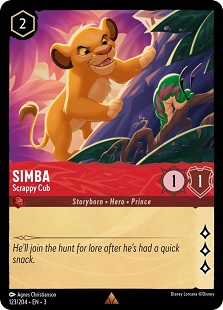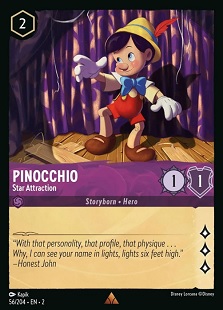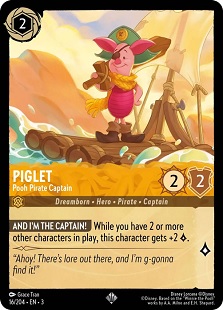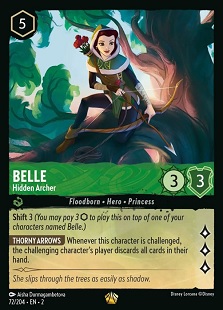When I was a kid and walked uphill to the card store, both ways, in the snow just to play Magic: The Gathering I would do a number exercise each time the "Standard" environment changed. For those unfamiliar with "Standard" it is a way to keep the game fresh by limiting the cards you can play to more recently released cards. Basically, the last 2 years of published cards. Lorcana isn't old enough for that yet, but I will endorse it when the time comes. The number crunching I did for that situation can really help when building decks in Lorcana as well so I figured I would walk you through it as I mix in the spoiled cards from Ursula's Return and reconfigure my previous data. If you're the type of person who avoids spoilers, I will mostly be talking about the numbers on groups of cards, not specific cards.
Today, I will be running through a few ratios and using them to build a deck. As usual, this deck will not be designed to dominate or even alter the top tier meta game. Rather, it will be a building block that will help you to build the deck you like to play. I never intend on anyone playing my list any more than I want to face 5 rounds of the same deck list in a tournament. That's boring and a large reason I stopped playing competitive Magic. The ratios we will consider today are Ink per Character, Lore per Character, and Lore per Ink.
I do need to mention one special caveat, cards whose text changes the ratio based on a situational will not be counted for their special case. Only the plain Jane normal reading of the card will be used so the data stays as "clean" as possible. For example, both Simba - Scrappy Cub and Piglet - Pooh Pirate Captain may both generate three lore but for our discussion Piglet only generates one. While both Simba and Pinocchio - Star Attraction will count the same.
Lets' start with the Ink per card ratio. As with all ratios it's just a simple fraction that can be divided to create a decimal and those decimals are compared to see the best color in an area. I take the list of character cards and count the total amount of Ink it would take to play every card and divide by how many character cards are in that color. This gives a numerical representation of how "fast" a color is. Of course, this is an average and some cards from the slowest color will be faster than some cards from the fastest color. Lorcana designers have done a good job keeping the average between 3 and 4. This is why in a typical game turn four is a good indicator of what each player is trying to accomplish. So, who's the fastest? AMBER, clocking in just a smidge over 3.5. While the slowest is Amethyst with 4.6. I would like to point out that all colors are getting faster in Ursula's Return so the game will speed up a bit. Most notably for the Ruby players since their Ursula cards are 0.7 faster than previous print average. Once again, this would not include abilities like Shift which is meant to speed things up by letting you play a higher ink card for less. Look at Belle - Hidden Archer. For my numbers she is 5 ink while with Shift she is only 3.
Should you pick colors based on the average speed? Of course not. That just provides a simple baseline. In Magic, it is more useful in a draft scenario; but, in Lorcana your draft decks aren't limited to two colors, so the Ink per Character is not as significant. Our next ratio adds to our information by determining the average Lore per Character. Basically, every character can generate X lore per turn. Your goal is to be able to mine Lore from one card multiple times or get more out of each card than your opponent. Here the Lore per Character can make you decide which color to use. If you and I had a deck of 60 with only the average stats of cards in that color my Sapphire would barely edge out your Emerald deck. It may surprise you, but these colors are the first and second highest average. While all colors were "weakened" in Ursula's Return, these two and Amber shared with the least change at only 0.06 per character card.
The last ratio is probably the most critical in Lorcana. That's the Lore per Ink ratio. Once again, there are individual cards that break the rule of thumb for colors since my numbers are only an average and do not take into account any extra abilities. I was truly surprised by the results. My own first deck in Lorcana was made for maxing Lore in the one and 2-drop cards wanting to abuse Lucky and Perdita and didn't use either of these colors. I've since discovered many players build with Lore per Ink as a central concept. You may have heard of it referred to as "Speed Lore" or "Burn" decks. Even these decks (mostly) don't use either color that wins the average. So, who wins? Who has the highest Lore per Ink available. Emerald followed closely by Sapphire. Both even got a boost in Ursula's Return. The biggest boost went to Amethyst but not enough to make up the previous difference.
Here is a deck list based just upon the numbers. Ultimately, this was built just for a building exercise. Surprisingly, I don't think it's that bad. Just remember QUEST! That is the deck strength and that is what you need to focus on.
By the Numbers | Lorcana | Dan Eckstein
- Characters (48)
- 4 Aurora - Regal Princess
- 4 Caterpillar - Calm and Collected
- 4 Cursed Merfolk - Ursula's Handiwork
- 4 Duke Weaselton - Small-Time Crook
- 4 Enchantress - Unexpected Judge
- 4 Flynn Rider - Charming Rogue
- 4 Hans - Scheming Prince
- 4 Mad Hatter - Gracious Host
- 4 Noi - Orphaned Thief
- 4 Prince Charming - Heir to the Throne
- 4 Queen of Hearts - Quick-Tempered
- 4 Robin Hood - Daydreamer
- Actions (4)
- 4 Hypnotize
- Songs (4)
- 4 Strike A Good Match
- Locations (4)
- 4 De Vil Manor - Cruella's Estate
Hope you guys have fun with this. Challenge yourself to play with these number and build your own deck with different color mixes. While it may not be the deck to get you crowned "Champion" it will be an excellent skill set to develop for your next sealed/draft night.




























